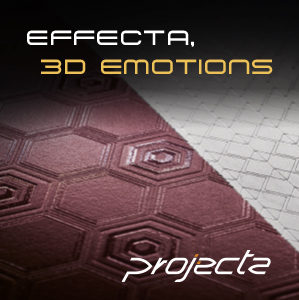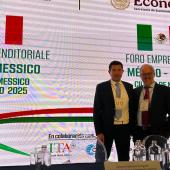Focus on large size: a new dimensional aesthetic
Pamela Albanese - TosiLab
Given the growing popularity of large and extra-large sized ceramic tiles, it is interesting to take a look at the various fields of design to find parallels and analogies that will enable us to identify a new dimensional aesthetic.
But let’s start with ceramic tiles. In their contemporary form, they fulfil the need to expand the sense of space in two key ways.
The first is physical and geometric in nature, and involves altering perspectives by increasing the dimensions of individual pieces. Tiles are transformed into ever larger panels, facilitated by technology which allows for ever smaller thicknesses and larger surface areas.
The second focuses on design and involves creating coordinated offerings that clad space in a systematic, modular way. This makes for a consistent and flexible overall project that extends over various spaces and offers plenty of scope for coordination.
What both cases have in common is the “box effect” trend which minimises the perception of interruptions and creates the illusion of a continuous surface that integrates seamlessly with the architecture.
This vision is now so well established that in order to take on a contemporary look a ceramic tile must automatically have a large size.
In the interior design sector, this trend has been reinforced by the growing use of “flowable” coatings such as resins and micro-cements which are capable of lending a sense of uniformity to visual spaces of any size. These materials have become particularly well established in public and commercial applications because they not only allow almost unlimited scope for customisation but also stand out for their complete uniformity, a characteristic that makes them ideal for the “less is more” aesthetic that is so popular amongst minimalist designers.
Turning our attention from interior to outdoor spaces, we find plenty of cases in which seamless surfaces are sought after in architecture. This gives rise to authentic architectural sculptures with homogeneous surfaces. For the new Dior boutique in Seoul, Christian de Portzamparc designed enormous walls that create a sense of fluidity as if they were made of white cotton fabric, the twelve constituent elements coming together to create a figure that resembles enormous flower petals.
But the ability to gracefully expand volumes and give them contemporary appeal is also evident in other related fields such as mosaic, where the individual elements are used to create ever broader visual concepts in which the perception of individual parts is lost within the final composition (one such example is Jungle Mosaico+). Another example is the complex and highly varied world of wallpaper. From the most exquisitely feminine glamour to the rigour of a more masculine elegance and the appeal of exotic atmospheres, the common thread is a search for the “ultimate”. The proposed decorative motifs draw from contexts that feature large and increasingly frequently life-size subjects, such as tropical forests, giant foliage, maxi-stripes and retro geometric compositions, as well as forays into eighties pop art. Elitis, for example, offers a watercolour polka dot pattern in a XXL size on Djinn fabric.
For devotees of the plein air style, the new wallpaper trend aims to bring the outdoor world into the home by creating highly faithful replicas of stone or wood in large sizes. This is hardly surprising considering that marble and authentic stone have never been so popular as in recent years, especially materials with distinctive aesthetics which are often recomposed in an “open book” style.
Although the factors behind the evolution of taste in interior design differ from those of other creative areas, there is nonetheless a high degree of correspondence. The first of these originates from world of communication and visual arts, and is evident in three distinct trends: a preference for live images, the concept of all-over graphic designs, and emotional close-ups. Now that the idea of a frame has been abolished, images are always used in their ideal size as if they are trying to break out of the confines imposed by the edges, and panoramic views have become one of the most popular techniques. All-over graphic designs extend both inside and outside the specific element and the space assigned to them, forcefully incorporating not just the container but often also the contents. Other examples can be found in works of art such as Jim Lambie’s installation in the Patrick Seguin gallery in Paris, where the macro markings that entirely cover the floor reference the sculptures suspended from the ceiling. The new visual representations accustom our eyes almost to a sense of alienation that has now become part of reality. And where images are absent, texts become dominant in terms of size, with headlines written in enormous font sizes.
The trend can also be observed in the world of fashion. Behind the functional need for convenience we find ultra-soft forms: extra-large trousers, wide bell-shaped skirts, oversized coats and baggy sweaters.
In the domestic environment, sizes have grown enormously. Lamps are larger than ever, armchairs and sofas oversized, mirrors enormous, beds are defined as extra-comfort, headboards are clad with sumptuous upholstery, bathroom washbasins are increasingly large and shower heads generously proportioned. It is likely that this shift in scale of household objects is part of an illusory desire to create an “expansion effect” capable of restoring a sense of depth to undersized building envelopes. In other words, it reflects an unconscious desire on the part of contemporary humans for greater living space.
Read the full article published on Ceramic World Review 116/2016
Did you find this article useful?
Join the CWW community to receive the most important news from the global ceramic industry every two weeks





















